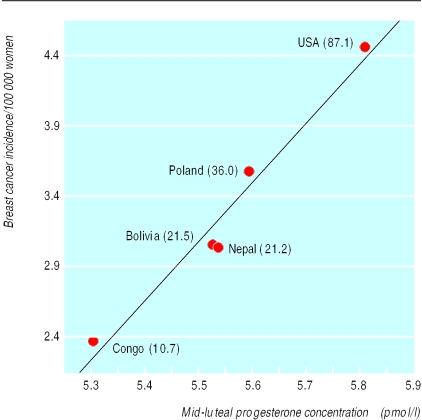Nutritional status influences ovarian steroid hormones and breast cancer incidence
The incidence of breast cancer is much higher among women in industrialised countries than among women in countries with more traditional lifestyles. Energy intake, energy expenditure, and energy balance may influence ovarian physiology and the concentrations of ovarian oestrogen and progesterone produced during the menstrual cycle. Oestrogen and progesterone are hypothesised to play a crucial part in the development of breast cancer in women.1 Women from populations with a high risk of breast cancer are expected to have comparatively high concentrations of ovarian steroid hormones.
Methods and results
Saliva samples were taken previously from women in Bolivia, the Democratic Republic of Congo, Nepal, Poland, and the United States.2 Samples were collected daily during at least one menstrual cycle from women 25 to 35 years old, and progesterone concentrations were analysed by radioimmunoassay.2 Mean concentrations were calculated for the fifth to ninth days preceding the start of the next cycle (mid-luteal phase); these are the days with the highest progesterone concentrations.2
The relation between these concentrations and the incidence of breast cancer in each country was investigated. The data on cancer incidence were obtained from the Globocan database of the International Agency for Research on Cancer (www-dep.iarc.fr/dataava/globocan/globoJava.html). The populations studied in this analysis are the only ones for which reliable values of ovarian progesterone are available. All variables used in this study were transformed to natural logarithms before the correlation analyses were performed.
Higher concentrations of ovarian progesterone in the mid-luteal phase were strongly associated with an increasing incidence of breast cancer (r2=0.968, P=0.0025) (figure): an increase in progesterone concentration of <70% coincided with a more than 8-fold rise in cancer rate. This pattern confirms the expected positive relation between concentrations of ovarian progesterone and incidence of breast cancer in these populations.1
Mean total energy intake was used as a crude indicator of the relative energy status of a population and its relation with progesterone concentrations was examined. The mean values used in this analysis came from the food balance sheets of the Food and Agriculture Organisation (http://apps.fao.org/page/collections); values used were 7.6 MJ/day for the Congo, 9.2 MJ/day for Bolivia, 9.6MJ/day for Nepal, 14.0 MJ/day for Poland, and 15.3 MJ/day for the United States. These values were positively and significantly correlated with concentrations of ovarian progesterone (r2=0.818, P=0.035). Thus, poor energy status in a population is associated with impaired ovarian function in women.
Clinical studies have shown that restricting energy intake frequently leads to recurring suppression of reproductive function. Such suppression ranges from reduced steroid production and anovulatory cycles to total amenorrhoea when conditions become severe. In these circumstances the lifetime production of ovarian steroid hormones is curtailed. In contrast, when the available energy is virtually unlimited women have frequent ovulatory menstrual cycles characterised by high hormone concentrations.
Comment
There is an important link between the risk of breast cancer and the nutritional status of a population; this link is mediated by ovarian sensitivity to environmental conditions. Although evidence of the link between ovarian function and breast cancer risk is based on the study of a limited number of populations (and important covariates such as age at menarche, parity, and breastfeeding have not been taken into account), the strength of the relation strongly suggests that it is an important biological phenomenon. Furthermore, since ovarian function responds to nutritional status, the risk of breast cancer may be modified if changes are made in a woman's lifestyle.3 An increase in physical activity and decrease in caloric intake may thus lead to lower concentrations of progesterone and oestrogen, resulting in a reduction in breast cancer risk.
Figure.
Relation between mean concentrations of progesterone in saliva during mid-luteal phase and age standardised (world population) rates of breast cancer per 100 000 women. Cancer incidence for each country is shown in parentheses. Both variables transformed to natural logarithms
Acknowledgments
We thank Peter T Ellison of Harvard University; owing to his understanding of the need to study the reproductive function of women worldwide, reliable data on hormone concentrations exist.
Footnotes
Funding: Norwegian Cancer Society grant number TP-49258/001.
Competing interests: None declared.
References
- 1.Jasienska G, Thune I, Ellison PT. Energetic factors, ovarian steroids and the risk of breast cancer. Eur J Cancer Prev. 2000;9:231–239. doi: 10.1097/00008469-200008000-00003. [DOI] [PubMed] [Google Scholar]
- 2.Vitzthum VJ, Ellison PT, Sukalich S, Caceres E, Spielvogel H. Does hypoxia impair ovarian function in Bolivian women indigenous to high altitude? High Altitute Med Biol. 2000;1:39–49. doi: 10.1089/152702900320676. [DOI] [PubMed] [Google Scholar]
- 3.Friedenreich CM, Thune I, Brinton AA, Albanes D. Epidemiologic issues related to the association between physical activity and breast cancer. Cancer. 1998;83(suppl):600–610. doi: 10.1002/(sici)1097-0142(19980801)83:3+<600::aid-cncr2>3.3.co;2-0. [DOI] [PubMed] [Google Scholar]



